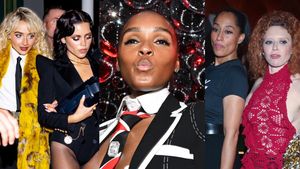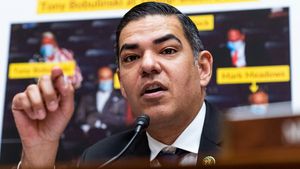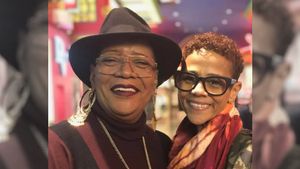In an excerpt of R. Couri Hay's book Secret Lives, the main character Rodney dresses himself up in a bit of leather-as-drag, pulling on an arm band, a motorcycle jacket, a jockstrap, and even going so far as drawing on a fake scar, applying temporary tattoos and a blonde moustache. In this get up, he hits the town in New York City, eventually winding up at The Saint, a private gay club. There, drugged up, he lets himself go, submitting to all his carnal desires, allowing himself to be touched and groped in the three-level space, while watching BDSM sex scenes put on by performers under various spotlights. In one vignette, bodybuilder lookalikes recreate a sauna scene that devolves into an orgy, in another, someone gets peed on, and in a third someone has a boa constrictor inserted into their ass. And while this is in part a work of fiction, it is meant to portray, and is based on, one of the earliest iterations of The Black Party, a real-life 40-year-old roving New York City nightlife institution, deemed by some to be the "father of all large circuit events," that could be putting on its last event this weekend.
"It was probably the biggest investment in a gay business that happened up until that time," Black Party producer Stephen Pevner tells Out of The Saint, a nightclub that opened in 1980 after a $4.5 million renovation. The Black Party was originally housed in that three-story building, replete with a planetarium at the top. "Maybe, when you convert it to 2019 dollars, it still very well may be that -- the biggest investment in gay business." According to DollarTimes, it would be equivalent to about $14 million.
"It was just phenomenal. Whereas other discotheques were satisfied with the disco experience, this was a cathartic experience. The place was transformative." The space, which hosted the likes of Grace Jones, Chaka Khan, Luther Vandross, Sylvester, and RuPaul for live performances, was considered as much an architectural wonder as it was a cultural one. In 1982 Robert Mapplethorpe shot select guest of The Black Party there. It cultivated not only a community, but an almost spiritual experience many felt needed to be preserved. So, when it closed in 1988, The Saint club transitioned into an The Saint at Large, a transient community that gathered for a few parties per year, the most infamous of which has remained, The Black Party.


Like in Hay's book excerpt, that party has remained a bit of everything. There is the music and the dancing, that feeling of community, but there is also the sex and fetish. Porn stars perform on the mainstage and men are tied and whipped, -- some have been hung from hooks piercing their skin. It's an experience for all the senses. Themes have included "Mineshaft," which featured decor as if one were going down into a mineshaft for miners, a play on a now-defunct BDSM club; "Submerged," which brought the feeling of being underwater replete with decor that evoked a submarine' as well as "Pigtopia" which is ... self-explanatory.
Year after year, attendees clothe themselves in their leather and costumes, to go out into warehouses and other venues, in a modern day iteration of a long, lost vernal equinox ritual. In that old ritual, they pulled on furs and spent the night in the woods getting high off mushrooms from the undersides of stones, all to celebrate the turning of winter to spring. In this modern iteration, under a strict no phones and no photography rule, sometimes upwards of 5,000 attendees, many of whom travel internationally for the event, are allowed to release themselves for 18 hours in a space built to Broadway production standards by Pevner and his team.
"We build a set for one night -- we build an experience from the ground up," Pevner, who has also worked in films and in theater, says. "From the lights, to the sounds and entertainment we offer, to the costumes, the makeup, to the entire experience, it's all a part of this narrative arc that's like an opera, but the people who are there dancing are the stars." However, that level of production requires a unique space that is both large and mostly blank. Which has, in part, put the entire event in danger.



After The Saint's official closure, the party continued in that same space on an ad-hoc basis. But when the new owners ended that relationship, the event moved, settling at the Roseland Ballroom in the early 1990s. There it remained for around 24 years, though for a majority of that time the venue was under the threat of demolition. The party's later migration from Roseland to a series of warehouses has proven much less successful.
"I got inspiration from places like Berghain in Berlin, which is an old renovated power plant that plays techno music," Pevner says. "You go in on a Saturday and it's not over until Tuesday. I felt that they really understood where music and culture and the art form of the night club was heading." The issue became those venues and something as American as apple pie: bureaucracy. Rising rents and zoning have increasingly complicated the process to a point that finds it untenable.
"For the past four years, it was a nightmare," Pevner admits. "We were losing venues up until like ten days out of the party. We'd have a contract, we'd be in discussion and something would fall through." One particular year saw a venue get cancelled days before, so the party wound up in a new space where they expected 3,000 people in building with a capacity of 1,500, -- lines queued up to four hours. Another year, a last minute venue change saw attendees huddled in groups for body heat as the venue had no heat of its own. This was the wild wild west of New York City warehouse locations. But Pevner hopes to solve many of those issues by moving to a new space ... in the Bronx.



"There's a natural resistance to it," Pevner admits. "I get a lot of letters like 'Whose bright idea was this? You gotta be crazy, no one is going to the Bronx.' But I had seen this venue four years ago and I thought it was beautiful and nicely situated. I'm positive that if we want to continue the party -- and I'm not sure we do -- it's a place that we could go to year after year." That space, the New York Expo Center, is 90,000 square feet of warehouse in the northernmost borough of New York City. Free shuttles from Hell's Kitchen as well as Williamsburgh will ferry attendees to and from the venue that "evokes Imperial Rome," which blends perfectly with the theme "Caligula, The Last Party." So if this is going to be the last Black Party, they are going out with a bang featuring DJs Boris, Roi Perez, Mike Servito, Ryan Smith, Byrell The Great, and DJ Harvey.
"This thing hasn't made money since Roseland, truthfully," Pevner says. "I believe in it and Oprah says, it's all about the intent, and our intent is right on but it's facing a transition period as a lot of businesses do every year." That transition period comes at a particularly fraught time when Pevner is currently in court over the $37 million estate that owns the trademark for The Saint. The litigation fees -- which according to Pevner, are already in the six figures -- alone have possibly stunted the ability for The Black Party to continue. But Pevner hopes it will.



"It's a right of passage and I believe in it," he says. "Whether it's financially feasible, or whether, because of this lawsuit, it's legally feasible, who knows, but I'm committed to it. By definition we offer a product that nobody else is offering: we are offering an underground experience and by virtue of our past success, we have the ability to pull it off like nobody can." Having 40 years of events means not only brand recognition on a consumer level, with a built-in audience, but also the sort of industry standing that makes almost impossible insurance conversations, easy.
"I feel like it's an art form that needs to be preserved," he continues." It's about the experience of an actual nightclub: You go in one person and there's this long kind of dance experience with your endorphins kicking in and the purging of having danced so long, and you emerge another person. That experience is dying in our culture and it needs to be savored."
RELATED | Inside the Vegas Party With Social Media's Favorite Porn Stars




































































